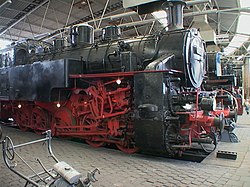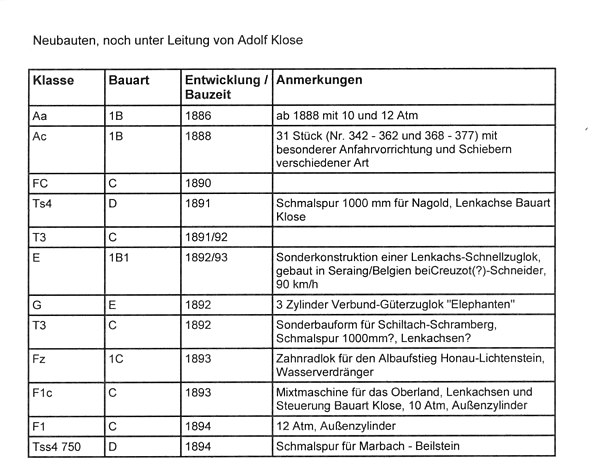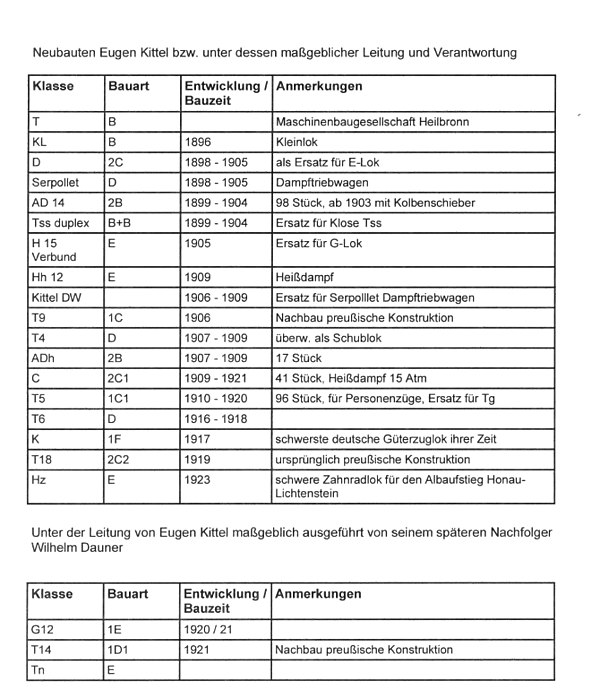Eugene Kittel

Eugen Kittel (born July 2, 1859 in Eningen under Achalm near Reutlingen , † May 23, 1946 in Stuttgart ) was a German engineer.
In addition to his predecessor Adolf Klose, in the late 19th and early 20th centuries he had a decisive influence on the modernization of vehicle technology and the further development of the Royal Württemberg State Railways (KWSt.E.). Railway historians still associate his name with the “ smock steam engine ” with a standing boiler. But numerous other locomotive designs also come from him or were created under his management, as well as the planning and commissioning of the Lake Constance paddle steamer Hohentwiel .
Professional background
education
After graduating from high school in Stuttgart in 1878, a year of practical work followed until he began studying mechanical engineering at the TH Stuttgart in the winter semester of 1879, which he completed in April 1883 with a diploma and first state examination.
Through his membership in a so-called “Association of Specialists” called “Die Hütte”, comparable to a student union, which, in addition to students of technical subjects, included numerous professors from the Technical University and distinguished technicians from industry and public institutions, he found contact and a. to Gottlieb Daimler , Robert Bosch and the later major industrialist Paul Reusch ( Gutehoffnungshütte , MAN , Deutsche Werft , Maschinenfabrik Eßlingen etc.). The acquaintance with Daimler later led to a professional collaboration with his son Paul, while the other contacts remained private throughout his life.
Work at KWSt.E.
On May 1, 1883, Eugen Kittel entered the service of the Royal Württemberg State Railways and was initially employed in various offices in different locations. This was followed by an official leave of absence from November 30, 1885 to May 10, 1886 to take the master builder examination, then on May 17, 1886 resumption of service as a "government mechanical engineer".
The decisive professional step was the entry into the mechanical engineering office on August 7, 1889 as a department engineer and close employee of Adolf Klose , under whose direction he was involved in various new designs, see the table below.
This phase of the professional career was characterized by great efforts and also difficulties, as Adolf Klose endeavored to meet the self-imposed requirements for the new vehicles without technical compromises, which in some cases led to very complex and maintenance-intensive designs. In addition, for the first time, the mechanical engineering office often carried out the design itself, down to the last detail, and this entailed strict specifications for the companies involved, predominantly the Esslingen machine factory .
On February 10, 1891, Eugen Kittel was appointed machine master and shipyard director in Friedrichshafen , which resulted in a temporary relocation of his area of activity to Lake Constance and the technical support of German Lake Constance shipping , which was under the control of KWSt.E, as a further task.
Eugen Kittel returned to Stuttgart on February 4, 1892, as chief inspector and head of the mechanical engineering office, and on October 3, 1895, he took over as the successor to Adolf Klose, who had retired in August 1895.
This was followed on February 24, 1897, the appointment to the building council, on July 29, 1899 the appointment as a member of the General Management of the KWSt.E and on November 14, 1908 the appointment to the senior building officer.
Towards the end of 1910, the Reich Railway Office in Berlin offered Eugen Kittel a position as “really secret and lecturing council”, which he declined because the activity was too administrative and had too little direct reference to technology and development.
W.St.E. 1919 (?) To 1924
Shortly before the merging of the state railways to form the Deutsche Reichsbahn , Eugen Kittel received his last promotion to the head of the machine department at the general management on January 30, 1920 through the W.St.E. (no longer royal after the abdication of King Wilhelm II in 1918) in the service of a director ”, original wording of the certificate of appointment. He held this position after the establishment of the Reichsbahn on April 1, 1920 until his retirement on August 31, 1924, his successor being long-term employee Wilhelm Dauner .
Member of the supervisory board at Maschinenfabrik Esslingen
From June 1924 he was a member of the supervisory board of the Esslingen machine factory for several years .
Dr.-Ing. E. h.
In recognition of his services to the modernization of the Württemberg railway system, the TH Stuttgart awarded Eugen Kittel the title of Dr.-Engineer E. h.
By decree of the Reich Minister of Transport of January 13, 1939, the last official title was changed to “Department President a. D. "converted.
No employee of the Esslingen machine factory
In essays and statements by railway historians and journalists, it is said again and again that Eugen Kittel was at least part of the time an employee of the Esslingen machine factory, ME for short. However, this is not true. Eugen Kittel was at no time in the service of this company, but exclusively an official of the (Royal) Württemberg State Railway and later of the Deutsche Reichsbahn during his entire professional life. In this function, however, he worked very closely with the "purveyor to the court" of the Württemberg railway.
The main developments in the railway sector
In general, two innovative basic lines shape the constructive work of Eugen Kittel, namely the consistent application and further development of the superheated steam technology introduced by him and the constructive adaptation of the locomotives to the special requirements resulting from the topography of Württemberg.
The most striking machines, which are described in detail in the relevant literature and whose development goes back to Eugen Kittel, are the express locomotive " Württembergische C ", also known as the "Schöne Württembergerin", the heavy freight locomotive K from 1917, heaviest and most powerful locomotive of its kind in all of Germany , the Hz cogwheel locomotive , specially developed for the Honau-Lichtenstein ascent to the Alb, and the Kittel steam railcar with a standing boiler for suburban traffic in Stuttgart and branch lines in the state.
While there are no known examples of the first two types that have survived, there are two completely preserved, but not running gear-wheel locomotives of the type Hz in museums in Berlin and Bochum-Dahlhausen, and a third machine was restored by a group of enthusiasts in Reutlingen. It has been fully operational since 2013.
A restored and operational vehicle of the steam railcar is still owned by a group of friends in Zurich. Before this railcar was equipped with the well-known Kittel boiler (superheated steam), Eugen Kittel, in collaboration with Paul Daimler, tested various test vehicles with internal combustion engines up to 40 hp and with an accumulator-fed electric drive. Like the original Serpollet boiler, these drives also turned out to be too weak and too prone to failure for the planned use.
In addition to the construction of locomotives, Eugen Kittel also occasionally devoted himself to the construction of wagons. In this context, it is worth mentioning the passenger car for suburban trains, which had closed car ends with rear doors and an exit in the middle of the car instead of the previously common open platforms.
The other wagon constructions were mainly for war-related conversions to hospital wagons or for certain transport tasks in the field of troop supply.
The following table gives an overview of all locomotives that were developed by Eugen Kittel or in whose construction he played a key role. The data was taken from Eugen Kittel's handwritten notes and occasionally deviate from the information in the relevant literature.
Locomotives
Ground steamer Hohentwiel
Since the Lake Constance shipping, so far under the Württemberg flag, the KWSt.E. under, their technical support and revision was also part of Eugen Kittel's area of responsibility. Under his leadership, the half saloon steamer Hohentwiel was designed and built from 1911 , which was put into service in 1913 and was in regular service until 1962. After that, the ship initially served a yacht club in Bregenz as a club house and subsequently fell into a complete wreck at various berths. From 1984 to 1990 a group of enthusiasts led by Captain a. D. Reinhard Kloser and District Administrator a. D. Klaus Henninger restored the Hohentwiel including the original engine (Escher-Wyss 1911) to its original state according to available plans and old photos and has been operating the steamer as planned ever since.
Other activities and functions
The diverse functions that Eugen Kittel held in the course of his professional life not only required numerous stays abroad in all of Europe and the USA and led to high academic and civil awards, but also often required his participation in extraordinary tasks due to his recognized specialist knowledge and experience.
In the years 1892 to 1898 Eugen Kittel had a teaching position at the Technical University of Stuttgart and held the lecture "Railway vehicles, railway wagons, transfer platforms and turntables, locomotives" at the chair for railway engineering in the winter semester .
In the course of the nationalization of the Gotthard Railway Company in 1903, there was a judicial dispute between the Swiss Federal Council and the Swiss main railway, whose ownership was to be transferred to the Gotthard Railway. After a few general reports had already been submitted, a commission of experts was appointed to which Eugen Kittel belonged and which had the task of working out concrete figures, in particular on the provisions required for further operation and the expected useful life, in the broadest sense, therefore, to assess the Gotthard Railway .
Eugen Kittel had a personal friendship with Count Zeppelin , which arose from an initial professional contact and deepened through personal interest in the development of aviation . The early test flights of airships took place in front of a large public and were followed from the lake by members of the Württemberg royal family and influential personalities from politics and industry. For this purpose, the KWSt.E. the necessary ships were ready and several times Eugen Kittel was able to help Count Zeppelin, who was constantly struggling to finance his projects, to further support.
He also used himself in 1906 for the count when he was awarded honorary membership in the Württemberg Engineers' Association, a subdivision of the Association of German Engineers (VDI) , and for its later admission to the main association. There was considerable resistance to Graf Zeppelin in both branches, since he was not an engineer by nature, but a general of the cavalry .
The reparations payments to France enshrined in the armistice treaty of 1918 included a. 5,000 locomotives and 15,000 railway wagons, for the delivery of which the French have continuously tightened the conditions. These demands could not be met and in order to be able to propose a realistic solution on the way to further negotiations with France, the German Foreign Minister Ulrich von Brockdorff-Rantzau and the later Finance Minister Matthias Erzberger (at that time still minister without portfolio) met on January 13th 1919 in Ulm with leading representatives of the state railways of Bavaria, Saxony, Württemberg and Baden. Eugen Kittel took part in this conference for Württemberg.
Eugen Kittel was in official contact with Oscar von Miller, as his membership of the price committee of the Association of German Railway Administrations (since June 30, 1920) automatically made him a member of the committee of the Deutsches Museum in Munich (until May 1925). He had already supported the establishment of the Deutsches Museum by providing and selling vehicles and models as exhibits. In negotiations with Gottlieb Daimler's widow, he succeeded in bringing the first vehicle powered by an internal combustion engine, with which Daimler took the first test drive in the garden of his villa, to the Deutsches Museum.
Anecdotal
The professional association “Die Hütte” (see above), to which Eugen Kittel belonged, organized a lecture evening once a week followed by a sociable drink , which was called a “pub”, as with student associations. Gottlieb Daimler showed up to the pub on November 10, 1885 with considerable delay and stated as an excuse that he had “been riding a velocipede too long in the garden.” Since Daimler was already of a set age and of stout stature, he was considered rather unsporting and his Statement didn't seem credible. When asked urgently, he finally reported that he had taken a first test drive in a motorized vehicle. This was the hour of birth of the automobile, which Eugen Kittel did not witness as an eyewitness, but experienced it very directly. He himself had neither a driver's license nor an automobile throughout his life.
Movie
- Railway romance : Eugen Kittel - a Swabian steam locomotive designer (episode 539)
Web links
- Railway pioneer rediscovered , lecture by Alexander Schweizer, Reutlinger General-Anzeiger
swell
- Technische Hochschule Stuttgart, program (= course catalog) WS 1896, library of the TH Stuttgart
- Eugen Kittel, handwritten diaries and notes, family property
- Eugen Kittel, official and personal correspondence, family property
- royal and other official documents, family property
- Kloser / Fritz, Das Dampfschiff Hohentwiel, Stadler Verlagsgesellschaft, Konstanz, 2nd edition 1995, ISBN 3-7977-0310-4
| predecessor | Office | successor |
|---|---|---|
| Adolf Klose | Chief Engineer of the Royal Württemberg State Railways 1896 - 1924 |
- |
| personal data | |
|---|---|
| SURNAME | Kittel, Eugene |
| BRIEF DESCRIPTION | German engineer |
| DATE OF BIRTH | July 2, 1859 |
| PLACE OF BIRTH | Eningen |
| DATE OF DEATH | May 23, 1946 |
| Place of death | Stuttgart |









